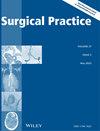保器官切除技术治疗肝包虫病
IF 0.3
4区 医学
Q4 SURGERY
引用次数: 0
摘要
本研究旨在介绍和评估肝包虫病手术患者采用保留器官切除干预治疗的结果。材料和方法。报告103例肝包虫病行根治性包皮包皮全切除术/非典型肝切除术的患者(男51/ 49.6%,女52/ 50.6%)的治疗结果。患者被分为两组:第一组,通过剖腹手术进行干预(n = 84);第二组,使用腹腔镜技术进行干预(n = 19)。在腹部干预组,不同方法间的实质夹层率比较,差异无统计学意义(p > 0.05)。未使用Tachocomb止血物质的平均止血时间较低(p = 0.17)。品客薯片运动期间的平均出血量显著降低(p = 0.043)。腹腔镜干预组在实质剥离率方面无统计学意义(p = 0.74)。使用Floseal止血基质的患者平均止血时间明显短于其他治疗组(p = 0.001)。在改进的腹腔镜普林格尔手法患者中,出血量明显少于未接受该技术的患者(p = 0.00008)。两组非特异性并发症发生率比较,差异无统计学意义(p = 0.76)。腹腔镜手术治疗组术后平均卧床天数明显低于对照组(p = 0.00001)。使用Pringle手法时进行腹部和腹腔镜干预统计证明其有效性。在腹腔镜手术中使用Floseal止血基质可以显著减少止血和术中出血的时间。腹腔镜手术的手术时间和实质清扫时间明显高于腹腔镜手术(p < 0.05)。腹腔镜和腹部干预的直接结果被证明是相似的。本文章由计算机程序翻译,如有差异,请以英文原文为准。
Organ-sparing resection techniques in the treatment of liver echinococcosis
This study aims to present and evaluate the results of treating surgery patients using organsparing resection interventions for liver echinococcosis.Material and methods. The study presents the results of treating 103 patients (51/49.6 % males, 52/50.6 % females) who have undergone total radical pericystectomy/atypical liver resection for liver echinococcosis. Patients were divided into two groups: Group 1, with interventions performed through laparotomic access (n = 84), and Group 2, with interventions using laparoscopic techniques (n = 19).Results. In the abdominal intervention group, there was no statistically significant advantage in the rate of parenchyma dissection between different methods (p > 0.05). The average time of haemostasis without the Tachocomb haemostatic substance applied showed a lower value (p = 0.17). The average blood loss during the Pringle manoeuvre was significantly lower (p = 0.043).There was no statistically significant advantage in the laparoscopic intervention group as regards the rate of parenchyma dissection (p = 0.74). The average haemostasis time was significantly shorter in patients using the Floseal haemostatic matrix than those treated otherwise (p = 0.001). In patients with the improved laparoscopic Pringle manoeuvre, blood loss was significantly less than in those who had not undergone the technique (p = 0.00008).No statistically significant differences were observed (p = 0.76) when comparing the percentages of nonspecific complications in the two groups. The average value of postoperative bed-day was significantly lower in the laparoscopic surgical treatment group (p = 0.00001).Conclusion. Using the Pringle maneuver when performing abdominal and laparoscopic interventions statistically proved its effectiveness. The use of the Floseal haemostatic matrix during laparoscopic operations allowed a statistically significant reduction in the time of haemostasis and intraoperative bleeding. The duration of the operation and the time of dissection of the parenchyma in the laparoscopic surgery were significantly higher (p < 0.05). The immediate results of the laparoscopic and abdominal interventions proved comparable.
求助全文
通过发布文献求助,成功后即可免费获取论文全文。
去求助
来源期刊

Surgical Practice
医学-外科
CiteScore
0.90
自引率
0.00%
发文量
74
审稿时长
>12 weeks
期刊介绍:
Surgical Practice is a peer-reviewed quarterly journal, which is dedicated to the art and science of advances in clinical practice and research in surgery. Surgical Practice publishes papers in all fields of surgery and surgery-related disciplines. It consists of sections of history, leading articles, reviews, original papers, discussion papers, education, case reports, short notes on surgical techniques and letters to the Editor.
 求助内容:
求助内容: 应助结果提醒方式:
应助结果提醒方式:


